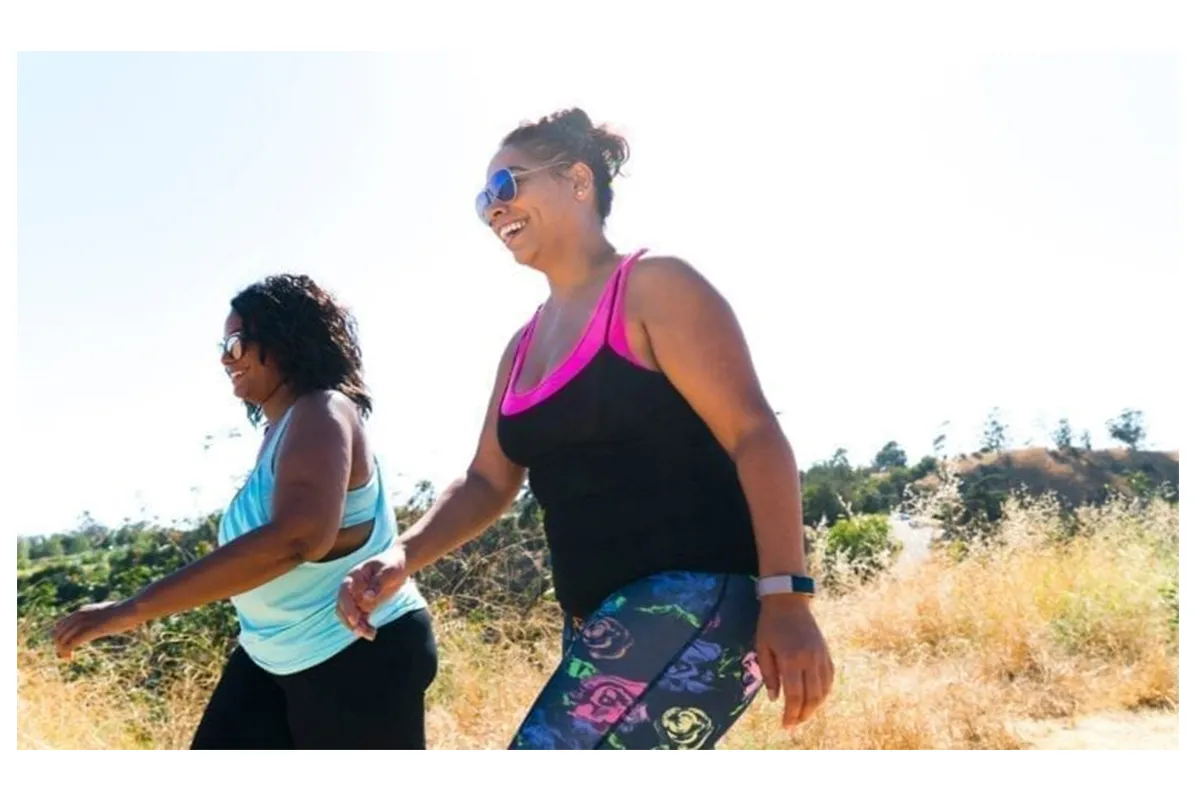Mastering Your 30-Day Walking Plan for Weight Loss
-
 Written by
Michael J. Ormsbee
Written by
Michael J. Ormsbee
- LAST UPDATED November 9, 2023
Committing to a 30-day walking plan is a fantastic step towards cultivating a fitness routine and ushering in a healthier lifestyle. It caters to everyone from beginners seeking to be more active, to seasoned walkers aiming to elevate their walking routine. The benefits offered by this monthly walking challenge are tremendous.
Getting Started with Your 30-Day Walking Plan
Before diving into a 30-day walking plan, it is important to make sure you set yourself up for success. Here are some tips to keep in mind as you embark on this exciting challenge:
- Get a Printable Tracker: Using a printable calendar or journal to track your progress during the 30-day walking plan to lose weight is highly recommended. Being able to see your milestones and consistency will help you stay motivated. Look for free downloadable 30-day walking plan trackers online.
- Get Proper Walking Gear: Ensure you have supportive, comfortable shoes designed for walking. If you’ll be walking outdoors, have layers available for unpredictable weather. Other useful gear includes a pedometer or fitness tracker to count your daily steps and distance. A water bottle and backpack help you stay hydrated and bring necessities like your phone, keys, and snacks.
- Know Your Starting Fitness Level: Gauge your current activity level so you can set realistic 30-day walking plan goals. If you are sedentary, start with shorter walks and gradually increase duration. Make goals based on time rather than distance at first. Get your doctor’s okay if you have health concerns.
- Schedule Your Walks: As with any new habit, consistency is key. Plan when you will walk each day and do your best to stick to the routine. Schedule walks when you have the most energy and are least likely to skip. Tell friends and family your 30-day walking plan to lose weight schedule to hold yourself accountable.
- Start Slowly and Listen to Your Body: It’s better to start slow and prevent injury than push yourself too hard. Gradually increase your walks as you build stamina. Take rest days as needed and do not try to walk through pain. Be patient with yourself! Completing 30 days is more important than speed or distance.
Now let’s explore a detailed daily schedule for your 30-day walking plan.

The 30-Day Walking Plan: Daily Schedule
Having a day-by-day plan removes the guesswork and helps you progressively build your walking routine over 30 days. Here is an example schedule for the 30-day walking plan:
Week 1
Day 1: 15 minutes
Day 2: 15 minutes
Day 3: 20 minutes
Day 4: Rest day! Enjoy a light stretch or yoga.
Day 5: 20 minutes
Day 6: 25 minutes
Day 7: 25 minutes
Aim for a brisk pace that elevates your breathing slightly. Walking 15-25 minutes per day allows your body to adjust to the new activity. Do not push through pain or soreness. Stretching and massage can aid recovery on rest days. Be sure to track your walks on your calendar. Small milestones will keep you motivated all month long.
Week 2
Day 1: 30 minutes
Day 2: 30 minutes
Day 3: 35 minutes
Day 4: Rest day
Day 5: 35 minutes
Day 6: 40 minutes
Day 7: 30 minutes
In week two, increase your walks to 30-40 minutes most days. This boosts endurance while still giving your body time to recover on lighter days. If soreness or fatigue sets in, don’t hesitate to take additional rest days as needed. Hydrate well before, during, and after walks. Proper fueling and listening to your body prevent injury and energize you.
Week 3
Day 1: 40 minutes
Day 2: 45 minutes
Day 3: 35 minutes
Day 4: Rest day
Day 5: 50 minutes
Day 6: 40 minutes
Day 7: 45 minutes walk + 10 minutes stretching
You are halfway through the 30-day walking plan – celebrate your consistency so far! This week build your walks up to 45-50 minutes. The day of 50 minutes challenges your endurance. Always warm up and cool down to maximize benefits and prevent strain. Add light yoga or stretching after a walk to enhance recovery. Varying your walking duration throughout the week keeps your body guessing.
Week 4
Day 1: 50-minute walk
Day 2: 60-minute walk
Day 3: Rest day
Day 4: 45-minute walk
Day 5: 50-minute walk
Day 6: 35-minute walk + 15 minutes of stretching
Day 7: Celebratory walk of your choice + treat yourself after!
The final week has arrived – go you! Listen to your body and do not overexert yourself as you complete the last days. If needed, adjust the duration of the 60-minute and 50-minute walks. The key is completing 30 days of regular walking rather than sticking to rigid times. End your 30-day walking plan with a celebratory walk at your own pace, followed by a reward for your incredible dedication!
Helpful Tips to Complete Your 30-Day Walking Plan
Incorporating the following tips into your 30-day walking plan can help you stay on track and achieve your goals:
Add Variety: Walking the same route every day can bore you quickly. To maintain intrigue and engagement in your routine, take your walking sessions to different interesting locations such as parks, hiking trails, or beaches. A change of scenery not only adds excitement but also challenges your body to adapt to new terrains and inclines.
Involve Companions: Consider inviting a friend or a family member for your walks. Not only will time go by faster, but you will also have someone to keep you accountable. You can also listen to new music or podcasts during your walks to make them more enjoyable.
Explore Interval Training: Consider incorporating interval training into your walking schedule. For instance, you can alternate between brisk walking for two minutes and slower-paced recovery intervals for one minute, repeating this cycle for about 20-30 minutes total. This increases your heart rate and is an effective way to boost cardio fitness.
Incorporate Hills and Inclines: Walking on inclines brings your workout to the next level by engaging different muscle groups and intensifying your efforts. Seek out routes with gentle hills before advancing to steeper inclines once your stamina improves.
Add Strength Training: Pair your cardio workouts with strength training. Implement exercises like squats, lunges, or planks, or even use light weights or resistance bands. This not only tones your muscles but also contributes to calorie burn, extending benefits beyond your walking sessions.
Monitor Your Posture: Pay attention to your walking form. Walk upright, gaze facing ahead, relax your shoulders, and swing your arms naturally. Make sure to engage your core and take long strides, so you move from your heels to your toes. Proper form minimizes the risk of injuries.
Set Realistic Goals: Don’t overwhelm yourself by setting unrealistic expectations. Start with walking distances and durations you can comfortably achieve and gradually increase as you build stamina.
Track Your Performance: Keep a record of your walks. Noting down your speed, distance covered, and how you felt during each session will help you observe your progress, keeping you motivated throughout your journey.
Stay Consistent: Consistency is key in any fitness journey. Make sure you stick to your walking plan even on days when motivation is low. This not only helps build a habit, but it also propels you towards your 30-day goal.
Be Patient and Positive: It’s essential to understand that results don’t happen overnight. Be patient and keep a positive mindset. Celebrate small wins along the way to keep your motivation levels high.
Completing a 30-day walking plan is within your reach. Stay positive, be kind to yourself on the journey, and rely on the tips above whenever you need extra motivation. Now let’s look at the many benefits this challenge offers.
See Also:

The Benefits of Completing a 30-Day Walking Plan
Committing to walking regularly for 30 days delivers amazing wellness perks. Here are some of the top benefits a daily walking routine provides:
Weight Loss: Regular walking burns calories and body fat, kick-starting your metabolism and increasing muscle mass. One study observed that individuals who followed a 30-day walking plan, walking briskly for 30 minutes a day, lost an average of 5 pounds.
Enhanced Cardiovascular Health: Daily walking strengthens the cardiovascular system by increasing heart rate and blood circulation, thereby improving endurance. Additionally, the 30-day walking plan reduces blood pressure and lowers bad cholesterol levels, significantly benefiting your heart health.
Improved Energy Levels: One of the rewards of a 30-day walking plan is the boost in energy levels. The increased oxygen intake and blood flow benefit every cell in your body, effectively combating fatigue and increasing vitality.
Stress and Anxiety Reduction: The rhythmic pattern of walking aids in releasing tension and worry, helping to alleviate stress and anxiety. The 30-day walking plan carves out a daily space for relaxation and mental rejuvenation. Walking in natural surroundings amplifies these stress-relieving effects.
Mood Enhancement: Regular completion of your 30-day walking plan triggers the release of endorphins, contributing to a positive mood. Research shows daily walking reduces feelings of depression, anger, and mental fatigue.
Strengthened Bones and Muscles: The weight-bearing aspect of walking assists in building bone density, and preventing osteoporosis. It also strengthens a multitude of muscles, improving overall posture, balance, and stability.
Improved Digestion: A daily walk can increase gastric mobility, enhancing digestion and promoting overall gut health.
Better Sleep: The completion of a 30-day walking plan can improve sleep by helping regulate your body’s internal clock, known as the circadian rhythm.
Increased Lifespan: Studies suggest that walking regularly can add years to your life by reducing the risk of life-threatening conditions like heart disease and diabetes.
Boosted Brain Health: Regular walking may slow cognitive decline and reduce the risk of dementia. It also nurtures creativity, providing time each day for thought and ideation in a relaxing setting without distractions.
Improved Respiratory Function: The 30-day walking plan, over time, enhances lung capacity, allowing for better oxygen intake. It can keep respiratory issues like asthma and bronchitis at bay.
Better Balance and Coordination: By walking regularly, you can improve your balance and coordination, reducing the risk of falls and injuries.
Strengthened Immunity: Regular walking can boost your immune function, helping your body combat illnesses more effectively.
Improved Blood Sugar Control: Regular physical activity like walking can lower blood sugar levels and improve insulin sensitivity, benefiting people with diabetes or pre-diabetes.
Sense of Accomplishment: Lastly, there is a psychological milestone in completing a fitness challenge like the 30-day walking plan. The sense of achievement can significantly enhance your confidence and self-esteem.
As you can see, sticking with a daily walking routine pays off hugely. Whatever your goals – better health, weight loss, improved mood, or less stress – a 30-day walking plan delivers results. Now let’s keep your momentum going strong after you complete the challenge.

Maintaining the Routine After Your 30-Day Walking Plan
The 30 days will fly by quickly, so be sure you have a plan in place to sustain your walking routine after completing the challenge. Here are some tips to make your new fit habit stick:
- Review Your Progress: Take stock of the physical and mental improvements you made during the 30 days. Read over your tracker and remember how awesome you feel after walks. This motivates you to keep going.
- Set New Goals: Don’t lose momentum! Outline new goals for the next 30 days like adding strength training, increasing distance, or trying new walking trails. Sign up for a 5K walk event. Having a new target keeps you focused.
- Accountability Is Key: Share your 30-day accomplishments with friends and tell them about your plan to continue. Their encouragement and occasional reminders to walk help you prioritize the habit. Join an online community or walking group.
- Make It a Lifestyle: Look at physical activity as a necessary part of your day instead of a chore. Wake up eager to walk and feel unsatisfied on rest days. Let your new fit identity inspire you to keep your walking habit thriving.
- Reward Your Consistency: After you complete 30 days of walking, treat yourself to something special like a massage, pedicure, or new pair of shoes. Remember to acknowledge your achievements along the way. Self-praise is a powerful motivation!
Whether you are brand new to walking or want to revitalize a lagging routine, there is no better way to establish a fit lifestyle than tackling a 30-day walking plan. Follow our tips and monthly schedule, and you will complete the challenge triumphantly. The consistent movement pattern will get you fit while the sense of accomplishment will boost your confidence. Here’s to a successful month of walking and beyond!

FAQs about 30-day Walking Plan
What will 30 days of walking do?
A 30-day routine of regular walking can provide multiple physical and mental benefits. Firstly, 30 days of consistent walking can have substantial impacts on your cardiovascular health. It can help lower blood pressure, reduce cholesterol levels, and enhance heart health. Secondly, walking is a weight-bearing exercise that can strengthen your bones and reduce the risk of osteoporosis. Thirdly, consistent walking promotes better balance and coordination. This routine also aids in weight loss and enhancing your muscle endurance and strength.
Mentally, regular walking can help to alleviate symptoms of depression and anxiety, as it triggers the release of endorphins – mood-enhancing hormones. It can also improve your sleep and overall quality of life when done consistently for 30 days.
Can you lose weight by walking 30 minutes a day?
Yes, it's possible to lose weight by walking 30 minutes a day. While the specific amount of weight you lose depends on your diet, existing weight, and intensity of the walk, regular walking can certainly help. 30 minutes of walking a day can burn anywhere between 100 to 300 calories, depending on your body weight and walking speed.
Walking can also increase your metabolic rate and keep it elevated for a period after you've stopped, increasing the total amount of calories burned. Furthermore, it's a simple and relatively easy form of exercise that can be easily integrated into everyday routines, making it more sustainable in the long term.
How much should I walk to lose weight in 30 days?
The amount of walking needed to lose weight in 30 days can vary depending on several factors including your current weight, diet, and metabolic rate. However, as a general guideline, most health organizations suggest a minimum of 150 minutes of moderate-intensity activity per week.
If weight loss is your goal, you might need to do more. For instance, you might aim for the equivalent of 30 to 60 minutes of brisk walking every day. This is roughly about 7,000 to 10,000 steps a day. However, it's essential to note that a healthy diet complements exercise for constructive weight loss.
How long does it take to see results from walking?
The time it takes to see results from walking can vary from person to person, depending on factors like consistency, intensity, and dietary habits. Generally, noticeable changes such as improved mood and better sleep can be observed within a week or two.
For physical changes like weight loss or increased muscle tone, it might take a few weeks to a few months. It's important to remember that these changes are gradual, and consistency is key. The more consistently you incorporate walking into your routine, the sooner you'll see results.






